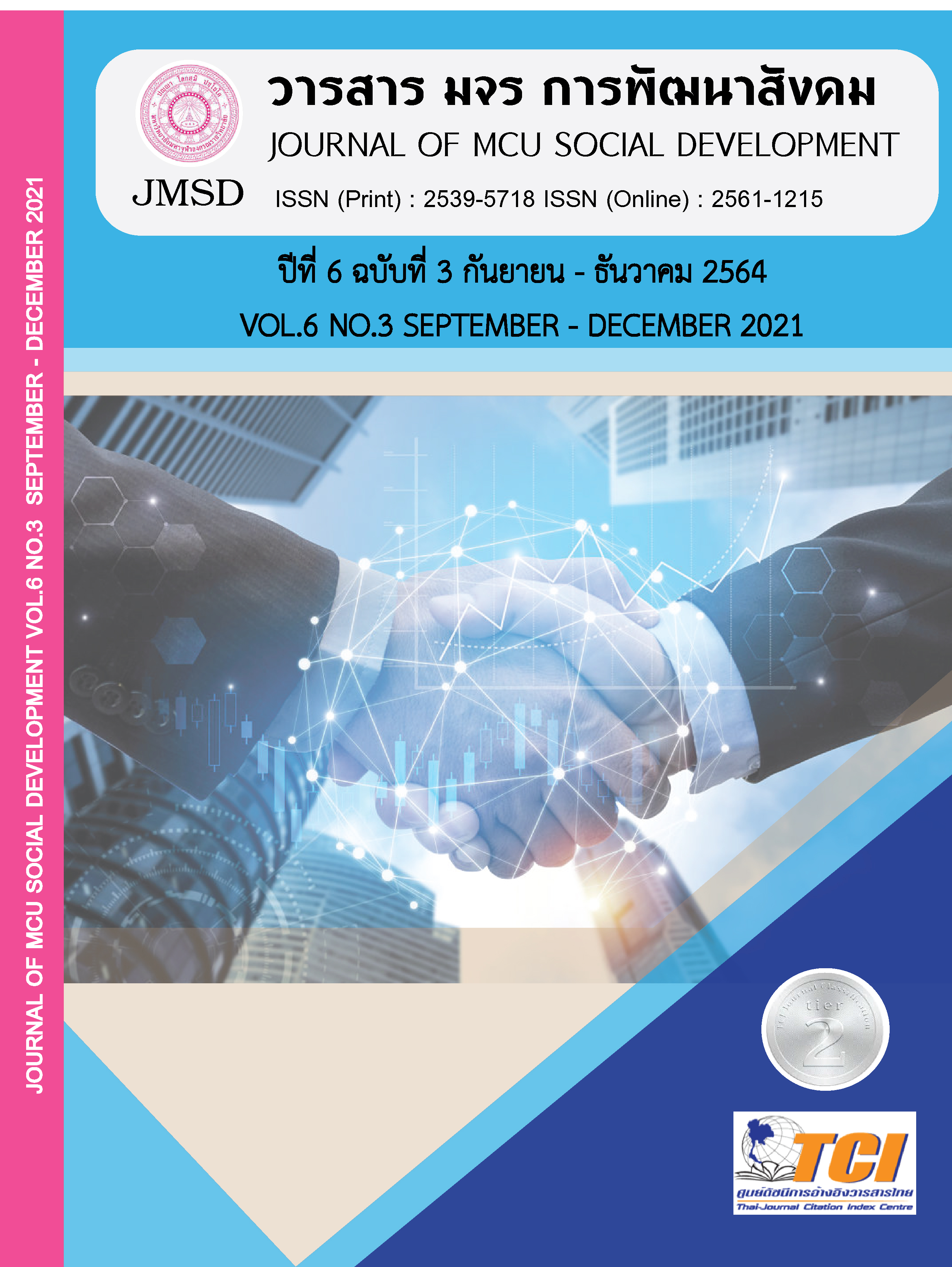ปัญญาประดิษฐ์ (AI) : วิถีการเผยแผ่แห่งอนาคต
คำสำคัญ:
ปัญญาประดิษฐ์ (AI), การเผยแผ่, ศาสนาบทคัดย่อ
แนวคิดหลักในการสร้างหุ่นปัญญาประดิษฐ์หรือ AI (ARTIFICIAL INTELLIGENCE ) เป็นการนำข้อมูลของงานใดงานหนึ่งมาออกแบบระบบให้สามารถปรับตัวและเรียนรู้ได้ด้วยตนเอง จากข้อมูลและบริบทต่าง ๆ เพื่อประมวลผลออกมาเสมือนการเลียนแบบระบบเซลล์ประสาทในสมองของมนุษย์ กระบวนการนี้เรียกว่า Deep Learning (DL) เมื่อผู้สร้างต้องการนำ AI มาใช้ในงานเฉพาะด้านศาสนา ที่มีพื้นฐานต้องการให้ศาสนิกของตนเป็นคนดี สร้างความสุขแก่มวลชน อนุเคราะห์โลก เพื่อประโยชน์เกื้อกูล ตลอดจนรักษาหลักธรรมคำสอนให้มั่นคง ก้าวทันต่อโลกที่เปลี่ยนแปลงตลอดเวลา จึงได้เริ่มมีการพัฒนาหุ่นยนต์ AI ขึ้นในประเทศญี่ปุ่น และทดลองใช้ในหลายปีที่ผ่านมา หุ่น AI ถูกสร้างเพิ่มขึ้นเรื่อย ๆ ด้วยจุดเด่นหลักคือ สามารถที่จะเรียกใช้ข้อมูลเดิม ๆ ซ้ำ ๆ ได้หลายครั้งโดยไม่ผิดพลาด ซึ่งเมื่อเทียบกับมนุษย์ที่ใช้สมองในการจดจำ ย่อมมีความคลาดเคลื่อน ผู้ควบคุมดูแลการปฏิบัติศาสนกิจต่างๆ ตามตารางเวลา ตลอดจนเป็นแหล่งเก็บข้อมูลขนาดใหญ่ (Big Data) มีความผิดพลาดน้อย เรียกใช้งานได้รวดเร็ว ทำให้สามารถแก้ปัญหาที่เกี่ยวเนื่องได้อย่างมีประสิทธิภาพเที่ยงตรงตามหลักคำสอน แต่ด้วยรูปลักษณ์ และการเข้าถึงบริบทที่มีต่อมนุษย์นับได้ว่าเป็นข้อด้อยของ AI ที่กำลังถูกพัฒนาอย่างต่อเนื่อง คาดว่าในอนาคตโอกาสที่ AI จะถูกนำมาใช้งานในการเผยแผ่ศาสนาจะกลายเป็นสิ่งที่จำเป็นมากขึ้น เพียงแต่รอโอกาสคือการเปิดใจยอมรับจากศาสนิกที่มองถึงประโยชน์มากกว่ารูปลักษณ์ ก็จะสามารถนำมาซึ่งวิถีแห่งอริยมรรคได้เช่นกัน
เอกสารอ้างอิง
มหาจุฬาลงกรณราชวิทยาลัย. (2539). พระไตรปิฎกฉบับภาษาไทย ฉบับมหาจุฬาลงกรณราชวิทยาลัย. กรุงเทพมหานคร: โรงพิมพ์มหาจุฬาลงกรณราชวิทยาลัย.
พระพรหมคุณาภรณ์ (ป.อ.ปยุตโต). (2554). พจนานุกรมพุทธศาสน์ ฉบับประมวลศัพท์. พิมพ์ครั้งที่16. กรุงเทพมหานคร: สหธรรมิก. หน้า 390.
หลวงวิจิตรวาทการ. (2546) ศาสนาสากล เล่ม 1-2. กรุงเทพมหานคร: อุษาการพิมพ์ หน้า 17.
จารุณี ดวงสุวรรณ.(2560). “ปัญญาประดิษฐ์ 1”. เอกสารประกอบการสอน รายวิชาวิทยาการคอมพิวเตอร์. (คณะวิทยาศาสตร์: มหาวิทยาลัยสงขลานครินทร์, (อัดสำเนา). หน้า 1-5.
ชูพันธ์ รัตนโภคา.(2559). ความรู้เบื้องต้นทางปัญญาประดิษฐ์. เอกสารประกอบการสอน สาขาวิชาเทคโนโลยีอิเล็กทรอนิกส์ (คอมพิวเตอร์). (ภาควิชาเทคโนโลยีวิศวกรรมอิเล็กทรอนิกส์ วิทยาลัยเทคโนโลยีอุตสาหกรรม: มหาวิทยาลัยเทคโนโลยีพระจอมเกล้าพระนครเหนือ. (อัดสำเนา). หน้า 283-284.
พุทธรักษ์ ปราบนอก, (2558). ศาสนาโลก. เอกสารประกอบการสอน (สาขาวิชาปรัชญาและศาสนา, มหาวิทยาลัยขอนแก่น. (อัดสำเนา). หน้า 50-51.
สุรเดช จองวรรณศิริ. (2562). The Power of AI ก้าวสู่ยุคแห่งปัญญาประดิษฐ์”. ACADEMY CLUB. Issue 19 หน้า 6-7.
ศรัณย์ศิริ คัมภิรานนท์. (2562). AI เทคโนโลยีอนาคตของประเทศไทย. บทความวิชาการ. สำนักวิชาการ สำนักงานเลขาธิการวุฒิสภา. 9 (5). หน้า 2-7.
อรพิน ประสงค์. (2562). ความรู้เบื้องต้นและประวัติของปัญญาประดิษฐ์ : ความเป็นมาของปัญญาประดิษฐ์และการนำปัญญาประดิษฐ์มาใช้ในเทคโนโลยีการแพทย์และการดูแลสุขภาพ. เอกสารประกอบการสอน (สำนักกฎหมายกฤษฎีกาปฏิบัติการ). (อัดสำเนา). หน้า 3-4.
เฟื่องลดา (สรานี สงวนเรือง), (2563), รีวิวเครื่องช่วยทำสมาธิ muse 2 ใช้แล้วเวิร์คมั้ย? LDA เฟื่องลดา. แหล่งที่มา :https://www.youtube.com /watch?v=eqvZI892GRo สืบค้นเมื่อ 1 เมษายน 2564.
สำนักงานส่งเสริมการค้าในต่างประเทศ ประเทศสิงคโปร์. (2561). ( เทรนด์ Artificial intelligence (AI) ในสิงคโปร์ .แหล่งที่มาhttps://www.ditp.go.th/contentsattach/230435/230435.pdf. สืบค้นเมื่อ 21 มีนาคม 2564.
สำราญ สมพงษ์, (2561), นักวิจัยAI กำลังพัฒนาไอทีเทียบชั้นพระวังคีสเถระ สนทนาธรรมกับพระพุทธเจ้าในโลกดิจิทัล.แหล่งที่มา : https://www.banmuang.co.th/news/ education/128928. สืบค้นเมื่อ 15 มีนาคม 2564.
อรพิม ประสงค์. (2562).ความรู้เบื้องต้นและประวัติของปัญญาประดิษฐ์: ความเป็นมาของปัญญาประดิษฐ์และการนำปัญญาประดิษฐ์มาใช้ในเทคโนโลยีการแพทย์และการดูแลสุขภาพ. แหล่งที่มา
https://7space.sgp1.cdn.digitaloceanspaces.com
/2S58/1529283558.b2240f7ca5574bfd419ef062752e05ff.pdf สืบค้นเมื่อ15 มีนาคม 2564. หน้า 2–3.
@MrVop, (2559). หุ่นยนต์ “นาดีน” ความก้าวหน้าของ AI ที่เริ่มรับรู้อารมณ์มนุษย์ได้แล้ว. แหล่งที่มา: https://stem.in.th/หุ่นยนต์-นาดีน-ความก้าวหน้า. สืบค้นเมื่อ 21 มีนาคม 2564.
ANONYMK. (2562). โพธิสัตว์AI นวัตกรรมสุดล้ำท้าทายวงการศาสนา ตัวช่วยเผยแผ่คำสอนนอกไตรปิฎก. แหล่งที่มา : https://www.unlockmen.com/masterpiece-noble-form-thonglor. สืบค้นเมื่อ [15 มีนาคม 2564].
Hossein Rahnama, (2562). Hossein Rahnama กำลังกำหนดอนาคตของ AI.แหล่งที่มา :https://www.facebook.com/thematterco/posts /2158319217716802/ สืบค้นเมื่อ 15 มีนาคม 2564.
MAIN STAND, (2559). รู้จัก "แอลฟาโกะ" A.I. อัจฉริยะที่ทำแชมป์โลก 18 สมัยเลิกเล่นเพราะไร้หนทางเอาชนะ. แหล่งที่มา : https://www.mainstand.co.th
/catalog/1-Feature/772 สืบค้นเมื่อ 21 มีนาคม 2564.
Praornpit Katchwattana. (2561). รู้จักแล้วจะรัก ‘หุ่นยนต์ดินสอมินิ เวอร์ชัน 4’ หุ่นยนต์สัญชาติไทยที่เกิดมาเพื่อ สังคมผู้สูงอายุ โดยเฉพาะ”. SALIKA. แหล่งที่มา : https://www.salika.co/ 2561/10/30/dinsaw-mini-version4-robot/ สืบค้นเมื่อ 21 มีนาคม 2564.
Suphaphorn Phumruang. (2561). ปัญญาประดิษฐ์ (AI) สมเด็จ ป.อ.ปยุตฺโต พูดไว้นานแล้ว. แหล่งที่มา : https://www.banmuang.co.th/news/ education/129400 สืบค้นเมื่อ 24 มีนาคม 2564.
Talk Together. (2560). ดังตฤณ เชื่อการปฏิบัติธรรมช่วยให้มนุษย์รอดพ้นจากการตกเป็นเหยื่อเทคโนโลยีได้ ในช็อตเด็ด Together EP.14. แหล่งที่มา : http://talktogethermrn.net/ดังตฤณ-เชื่อการปฏิบัติ /. สืบค้นเมื่อ 24 มีนาคม 2564.



